Article by Matt Schiemer
June of 2024 marked the 17th Texas 200. It was my eleventh. Ever since I first came across the Texas 200 in 2012, I have heard about its reputation as being a downwind sleigh ride. In fact, that’s one of the first things people will tell you when trying to minimize the difficulty of the event. And it’s true that the prevailing winds on the South Texas Gulf Coast in June are out of the south/southeast, making the 200-mile, 5-or-6-day sailing expedition anything from a run to a broad reach, with the wind typically over the starboard quarter much of the time. And it seems that was indeed true for the Texas 200 for a number of years. You could take it to the bank. Until recently.
It feels like it’s been years since that’s been true now. The wind is now much more unpredictable during the second full week of June, when the Texas 200 is always held. Five or six years ago we had a late spring “norther” come through the week before the event, bringing stiff north winds to the coast for most of that week. That year, the norther blew itself out a few days before the start of the 200, and after a day or so of calm, shifty winds, the “normal” S/SE prevailing wind returned, just in time for 60 or 70 small sailboats to set out from deep south Texas and make the 200-mile trek north for a week.
A year or two later, an early season tropical storm formed in the Gulf of Mexico as the Texas 200 was kicking off, and slowly made its way toward the coast all week. On day 3 of the event, we held an impromptu Captain’s Meeting at camp to review the latest forecast, which indicated landfall near our finish line about 36 hours after we were set to complete the event. Some boats pulled out at that point, while others sailed straight for the finish line without stopping at the remaining camps, in order to get in early. Most of us put our trust in the weather forecast (not sure why), and sailed the rest of the event as planned, and made it in without a problem. The tropical storm did what the forecasters said it would do, and made landfall not far from where we finish the event, about a day or so after we were all packed up and gone. Another close call.
Fast forward another year and we had yet another late season norther predicted to come through the week before the event, threatening to give us dreaded north winds for the first day or two. While that forecast wound up changing a bit, in our favor, we did indeed suffer from north winds due to another early season tropical storm spinning counter-clockwise out in the Gulf of Mexico. That was the year that over 70 boats started the event and only two boats made it to the finish line in Magnolia Beach without using a motor. One was Ellen Falterman, who not only didn’t have a motor, but she didn’t have a sail either. She rowed the entire thing in a modified aluminum canoe. The only sailor to make it 200 miles, straight into the wind, without the use of a motor, was Pat Hollabaugh, in his Mayfly 14. Myself and many others tried to do what Pat did, sailing into the wind for days on end, tacking hundreds if not thousands of times per day. But most of us fell far short of achieving what Pat did that year and dropped out 50-100 miles short of the finish line. That was a very frustrating year for everyone.
So this year, as we made our way through the month of May, with nearly 80 boats registered for the event, we all watched the long-range forecasts nervously to see if we’d get a “normal” year of S/SE winds—something that for so many years we all took for granted. We had a few late spring northers come through in May, which is fairly typical, but as we moved into June, things were looking pretty solid. The last norther was at least a week into our rearview mirrors, and the S/SE winds had fallen into place.
All was right with the world again until about 5 or 6 days before the event, when the forecast suddenly changed, and nearly all of the weather models started showing another norther coming through right at the start of our event. The chatter on our Facebook page turned from packing and last-minute prep to commentary on the now very unfavorable weather forecast. We even had a few participants drop out of the event during those few days where the forecast showed several days of north winds, due to an unwillingness to start something that would be nearly impossible to finish. But then a few days later, after we had all whipped ourselves into a frenzy, the forecast changed again. We no longer had a norther to contend with, it would seem, but there was a bit of uncertainty in terms of what we’d actually experience: possibly really light air, possibly no wind at all, or possibly a very normal year of S/SE winds in the 15-25 knot range. Mother Nature was toying with us.
And with that weather uncertainty on everyone’s minds, the time had come for us to hook our trailers up to our tow vehicles and make the trek down to deep South Texas, for the start of another Texas 200.
Day One started out as expected—light S/SE winds that pushed the fleet up the Laguna Madre toward the land cut at a slow but respectable pace. We wound up with about 70 boats actually starting the event, and by mid-morning things were looking pretty good, with much of the fleet spread out in a long line in the ICW, making our way north at about 4 knots. However, the lazy morning was about to get very interesting, very fast. Ahead of us were some dark skies, and it was pretty clear a small storm cell was passing in front of the fleet. The skies continued to get darker and darker, and then it became clear we’d have some type of impact. The wind started picking up and the air got cooler. For a few minutes it looked like we’d potentially benefit—it was passing in front of most of us, and it appeared we wouldn’t actually get caught in the storm itself. Maybe we’d just get some cool air and a stiffer breeze out of it? Well, that wasn’t in the cards. Over the next few minutes the wind picked up considerably, and then it became clear that we were going to be dealing with a hairy situation. For most of us it never really rained and the storm didn’t pass directly over us, but we did get a wind shift and a significant increase in wind strength. The wind was now coming almost directly out of the north and it was blowing about 35 knots and gusting a bit higher. Some folks claim it was blowing 40 knots and gusting up to 50. Either way, it was a lot of wind, and it took its toll on our fleet of small sailboats.
The wind was now coming almost directly out of the north and it was blowing about 35 knots and gusting a bit higher. Some folks claim it was blowing 40 knots and gusting up to 50. Either way, it was a lot of wind, and it took its toll on our fleet of small sailboats.
As the wind picked up it was clear it was going to hit quickly, and there was no time for me to make it to shore. I’d have to deal with this one on the water. In those situations my go-to move is to quickly drop sail and wrap it up tight, and then to throw my anchor over. My anchor line is pre-fed through a chock at the bow, so all I need to do is toss the anchor and 6-foot length of chain overboard from the cockpit, and it’ll set and point me into the wind and waves. That is exactly what I did, and it worked perfectly. Within about two or three minutes I had the sail down and all wrapped up, and I was pointing into the building wind and waves. It really never got too bad for me, with the exception of maybe 8 to 10 waves that broke over the bow and partially filled the cockpit with water. But I was able to bail and keep up with it, so overall, my experience with this storm was fairly benign.
Others didn’t fair so well though. A number of boats capsized, and others held on for dear life, trying to sail their way through this storm without dropping their sails. Interestingly (and surprisingly), several participants told me that they sailed through this storm with sails up not really by choice, but by necessity, since their particular sail/halyard/reefing configuration did not allow for shortening sail or even dousing the sail without some type of fairly involved series of steps which in some cases aren’t even possible while sailing or even on the water at all. This is really not advisable on the Texas 200, and some of these participants found out the hard way. The scariest part of the storm—which only lasted maybe 45 minutes—was when a fellow Texas 200 participant took to VHF channel 16 to report coming across a capsized Texas 200 boat with nobody aboard or anywhere within sight. The US Coast Guard picked up on this radio exchange, and the back-and-forth for the next 20-30 minutes was a bit unnerving. It took several hours before reports came in that the crew was picked up by a fishing boat, and were unharmed. They got lucky.
Once the storm passed, the wind was light and fluky for a while, as you’d expect, and then it eventually settled back into a light S/SE pattern and the fleet was able to make it to Camp One by late afternoon. However, when I walked the camp just before sunset only 50 boats had made it in out of the approximately 70 boats that had started. We’d lost 20 boats on Day One, presumably due to the impacts of the storm. So much for the benign year with a 90% finish rate.
Day Two started out with absolutely no wind. The water in the land cut looked like a sheet of glass. Most of the fleet launched anyway, and we all just drifted, motored or paddled around for a bit before the wind eventually picked up. It wasn’t great, but at least we were sailing. At some point that morning I decided to launch a makeshift water sail, something I’d done a handful of times over the past five or six years, after accidentally discovering this type of sail on a really light wind day. Water sails were common a few hundred years ago in the days of the square riggers. They were part of a boat’s light air sail plan, and were deployed below the boom, hanging just above the water, as the name would imply. In my case, the water sails that I’ve used over the years aren’t proper sails—rather, I tend to use either the rectangular piece of poly tarp that serves as my tent’s ground cloth, or a section of canvas that I use to shade my cooler. In this year’s Texas 200 it was the canvas cooler shade that was pressed into service as a water sail.
By mid-afternoon, the wind picked up a bit more and the sailing was quite good the rest of the day. The ESE winds in the 10-15 knot range allowed most of us to make camp after about 10 or 11 hours on the water, arriving prior to sunset.
Day Three was almost a carbon copy of Day Two, with the fleet awakening to glassy conditions, which eventually turned into a light ESE breeze that ever so slowly pushed us north. But prior to hitting Corpus Christi Bay, much of the fleet made a stop at the only real slice of civilization we’d have access to all week: Snoopy’s Restaurant and Marker 37 Marina, which lie only 50 yards outside of the ICW, and are honestly just too tempting to avoid after 3 days on the water. As one of very few motorless boats trying to finish this event in the allotted 5 days, I stopped in at Marker 37 Marina for a very short time, probably less than 20 minutes total, just to buy some more water and restock my cooler with ice. Although I was tempted to stay and socialize over lunch at Snoopy’s, I really needed to forego that luxury this year, and get back on the water to continue pressing north.
The rest of the day was fairly benign, with the exception of another storm that threatened us just north of Corpus Christi Bay, but it passed north of the fleet. The only real challenging part of the day, and it wasn’t so much challenging as it was time-consuming, was tacking up the Corpus Christi Ship Channel, which is a 5-mile long channel connecting Corpus Christi Bay to the Port Aransas area. Most years, with S/SE winds, this channel’s orientation makes for a close reach or close-hauled sail, which is a nice change of pace from the “downwind sleighride” we have for much of the rest of the week. However, this year the afternoon winds were out of the east, which meant tacking the entire way up this channel. It wasn’t bad though, and was almost enjoyable at times, and after maybe 2 ½ or 3 hours I finished my tack-a-thon and made the turn north, into the Lydia Ann Channel, for a nice downwind run the last six miles or so to Camp Three, at Mud Island (which is much nicer than it sounds). I got in to camp right at sunset, about 8:30pm, about 14 hours after setting sail that morning. Before it got dark, I counted 45 boats in at Mud Island, which was really good considering that we had 50 boats in at Camp One; most of the fleet that survived the storm on Day One was still in the event.
Day Four started early for me, due to it being the longest day of the event, with nearly 50 (statute) miles to sail to get to Camp Four. I set sail just after 6:00am, about 20 minutes or so before sunrise, in light air that was pushing me NNE across Aransas Bay at about 2 knots or so. With my water sail set and my thermos of hot coffee in hand, I wondered how the rest of this event would play out for me and the other motorless boats. At this point, we’d sailed through the portion of the Texas coastline with a generally N-S orientation, which allowed us to make progress with each afternoon’s onshore east winds. But now we were into what is known as the Coastal Bend, where the coastline follows a NE-SW orientation, making the afternoon east winds less of a beam reach and more of a close-hauled affair, or worse.
Would we continue to have glassy conditions and light air all morning, or would we be a bit more fortunate and get some decent wind? Would this be as far as the motorless boats got on this event, before dropping out? Would those of us without iron gennies be able to actually make it to Camp 4 and maybe even into the finish line at Magnolia Beach in time for the Shrimp Boil and celebration on Friday afternoon?
For the first few hours of the morning the answer to these questions was generally positive, as the ESE winds pushed me along close-hauled, without the need to tack. It would likely be an extremely long day, maybe even in the 16-hour range, but it was looking like most of us would actually be able to make Camp 4 if things didn’t change much. But my optimism didn’t last long. By late morning we had another storm cell on the horizon. With many miles to go I didn’t want to stop my forward progress, so I just sailed on, toward the storm. Fortunately, this particular cell passed in front of me, with no direct impact. Unfortunately though, in its wake was about a three hour period of very light, shifty winds, and even periods of absolutely no wind at all. And all this happened right as I was leaving Aransas Bay and heading into what we call the “back bays,” which are a series of three smaller bays connected by a number of long oyster reefs, which require precise navigation. Making your way from bay to bay requires passing through very narrow cuts or “dugouts,” as they are known locally. This was the first time the event would become somewhat maddening for me. With many miles in front of me, and nearly no wind at all (or wind right on the nose), I had to paddle much of the time and perform a number of “paddle-assisted short tacks” through the cuts and dugouts. This back bay area, which consists of Carlos Bay, Mesquite Bay and Ayres Bay, is roughly ten miles in total distance, and it took me about five hours to traverse, maybe longer. It was not a particularly enjoyable afternoon.
I finally made my way out into open water in San Antonio Bay by about 5:00pm or so, and by then the wind had come up and was blowing fairly steady at 8-10 knots, but it was out of the east, and I was unable to point toward camp. I would have to tack my way there. Even if I were able to sail to camp on a single tack, there were still more than 20 miles to sail, with about 3 ½ hours of daylight left. That would have been tough, but doable, with an arrival time of maybe 9:30pm or 10:00pm. It would have meant a bit of night sailing, and about a 15 or 16 hour day, but at least I’d have made it to camp. But with the wind out of the east, I would have to tack my way to Camp Four, which would make it at least an 8 or 9 hour sail. I was already pretty tired after about 11 hours on the water, and the frustrating sail through the back bays, and I really didn’t think I had enough in me to make it. This was the first time I realized that I’d most likely be dropping out of the event, or sailing a full extra day to make it to the finish line, arriving a day after the shrimp boil and celebration had ended.
I wasn’t really sure what I wanted to do, but I was pretty much in the middle of nowhere, with the nearest road and boat ramp to use to drop out of the event likely being in Seadrift, about 15 miles or so from my current position. Not wanting to drop out quite yet, I continued to push forward, tacking my way northward toward Camp Four, knowing full well there was no chance of making it. I eventually decided to make camp at a shell beach known as Panther Point, and made it right as the sun was setting, more than 14 hours after setting sail earlier that day. I was buddy-boating with Chuck Pierce who was also sailing motorless, and he joined me at Panther Point about 45 minutes after I got in. We decided we were going to try to make it to the finish line at Magnolia Beach in time for the shrimp boil the next day, and we talked through our options.
Option 1 was to head back out and set sail immediately, and just sail through the night and see where it would take us. However, by this time, it was approaching 10:00pm and we were tired and hungry. So we decided to eat some dinner and get a few hours sleep, and set our alarms for 3:00am to get back on the water and continue our trek north.
The next morning we were on the water by about 3:30am, and found ourselves with a bit of luck, with light winds that pushed us northward at about 2 or 2 1/2 knots, without the need to tack. We had about 38 miles to sail to the finish line, and a shrimp boil that was starting in about 12 hours. If we could just average a little over 3 knots, we’d be able to make it. We had a glorious night sail under clear skies, with the Milky Way shining brightly above us, as we slowly made our way for South Pass, which is a narrow cut in a long series of oyster reefs that separate San Antonio Bay from Espiritu Santo Bay, on our passage up to Magnolia Beach.
We reached South Pass right around sunrise, at 6:30am, and on a single tack. So far so good! Once we passed into Espiritu Santo Bay, our luck continued and we were still able to sail toward our destination without the need to tack. We weren't quite making the necessary 3 knots though, and so our ability to arrive by the 3:00 pm start of the shrimp boil was very much in question. This continued for several hours, and we eventually made it to the vicinity of Port O’Connor, at the upper end of Espiritu Bay, by about 11:00am or so, only tacking maybe two or three times in the process.
But that’s where it got difficult again—in fact, it got downright maddening. As the overnight and early morning wind shifted into a sun-driven onshore breeze out of the east, we were no longer able to avoid tacking. In order to make it out of Espiritu Santo Bay and into Matagorda Bay, there was about a 2-mile section that we had to sail through, including a few twists and turns through some narrow channels and a few marsh islands. And that 2-mile section just about did me in, physically and emotionally. I was tired. Both of my knees were bruised and one was cut open and bleeding from the extensive tacking I’d done the past few days, which necessitates crawling back and forth across my boat’s small cockpit. So as I started into what would be dozens and dozens of tacks through that last bit of Espiritu Santo Bay, I was not really doing all that well. Each tack under the mid-day Texas sun was a bit more infuriating than the last, with the cumulative impact of making almost no ground starting to take its toll. The wind was just too light to really get a good line and make much headway, and to add insult to injury, the tide was coming in the nearby Pass Cavallo inlet to the Gulf of Mexico, and so we had both wind and current on the nose.
In the past half day or so since things started to get difficult I had decided I was going to dig deep and try my very best to finish the event though. In part, I wanted to just see if I had it in me, to take the stubborn position of “I’m going to finish this darn thing!” But it also became a little bit about my father, who had passed away only a few months prior. My dad—known to many of us as “The Captain”—taught me to sail when I was about 5 or 6 years old, and was part of many of my sailing adventures for most of my childhood. And so I had pretty much decided that this year’s Texas 200 was going to be somewhat to honor him, and that pretty much sealed the deal: I was going to get to Magnolia Beach, no matter what. So I continued forward, one demoralizingly, ineffective tack after another.
It was nice having Chuck right there with me pretty much all week, and especially during the frustrating parts of the event—including this difficult push through to Matagorda Bay. But after a few hours, as I slowly clawed my way forward seemingly making 100 feet good on each long, slow tack, Chuck started falling behind, and eventually pulled up on a spoil island. He hailed me on the VHF radio and informed me he had suffered a few equipment failures, including a crack in his mast and in one of the akas on his small trimaran. This was in addition to a jury-rigged rudder gudgeon he had been dealing with for a day or two. It would not be possible for him to continue; he needed to drop out there near Port O’Connor, and so I would have to push on by myself.
After about 4 ½ hours of tacking and paddling and cursing my way through that last segment of Espiritu Santo Bay, I came out of what’s known as “Big Bayou” and was into Matagorda Bay. I tacked a few more times to get out past the Port O’Connor jetties, and then was finally able to turn about 90 degrees to port, putting the wind almost right behind me, and pointed toward the finish line at Magnolia Beach. It was blowing 10-15 knots and I settled into a fairly comfortable downwind sail, a little over 10 miles from the finish line. It was about 3:30pm and it was the first time in several days that it seemed I’d actually be able to make it to the finish line in time to join the festivities. And that’s exactly what I did. The bow of the Mystery Machine pushed up onto the beach at Magnolia Beach just before 6:00pm, and I was handed a few cold beers within seconds of stepping off my boat, as the shrimp boil continued only a few yards away.
I was the last boat in that day, and one of only 6 or 7 motorless boats that made it to the finish line in the allotted five days. There were plenty of other boats that made it —probably about 30 or 35 of the 70 boats that started five days earlier in Port Mansfield—but they had all motored for portions of the day most days. And of the motorless boats that made it, I believe I was one of only two monohulls, the other one being, you guessed it, Pat Hollabaugh. I was in very good company. •SCA•



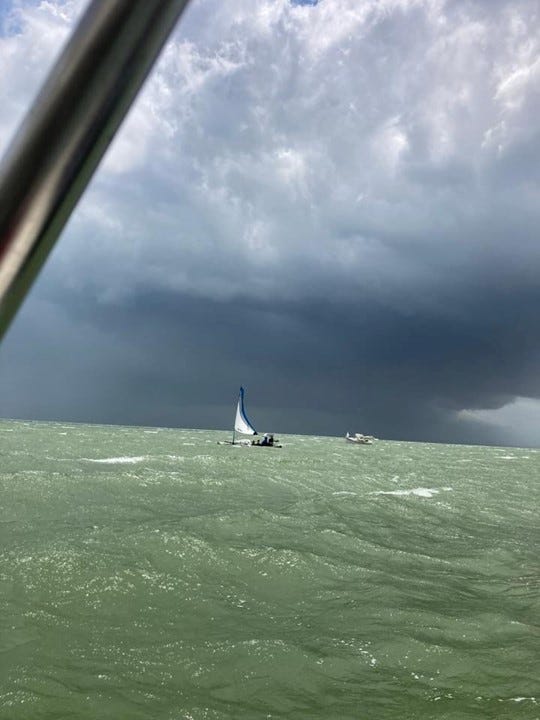
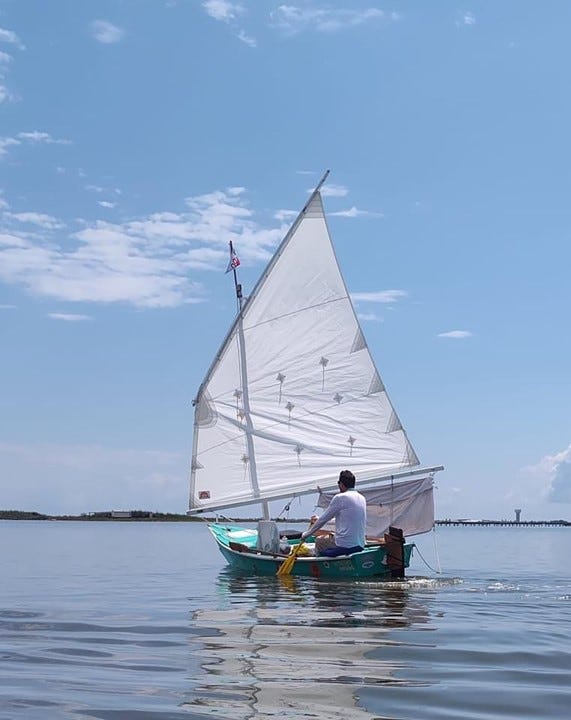
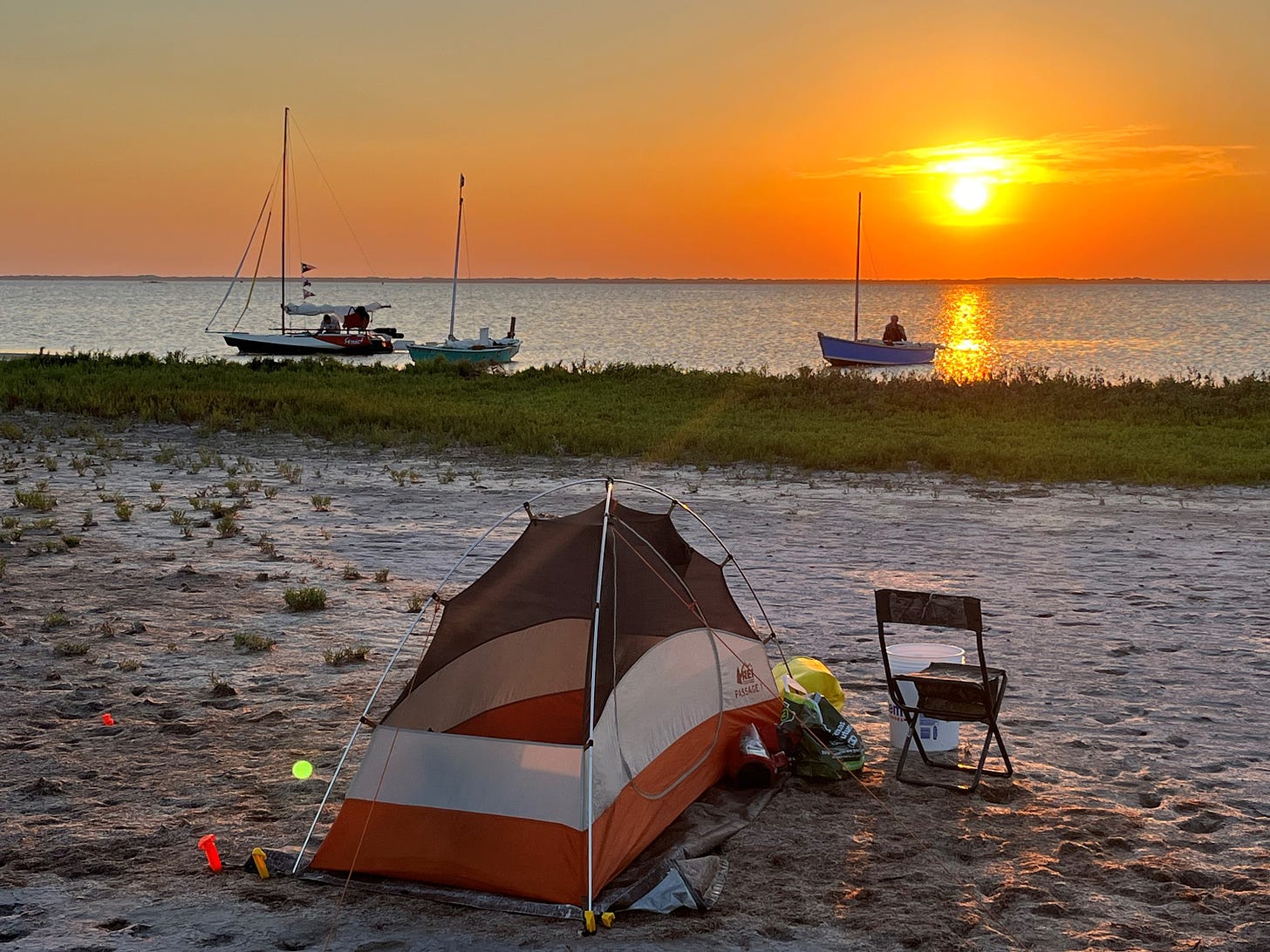
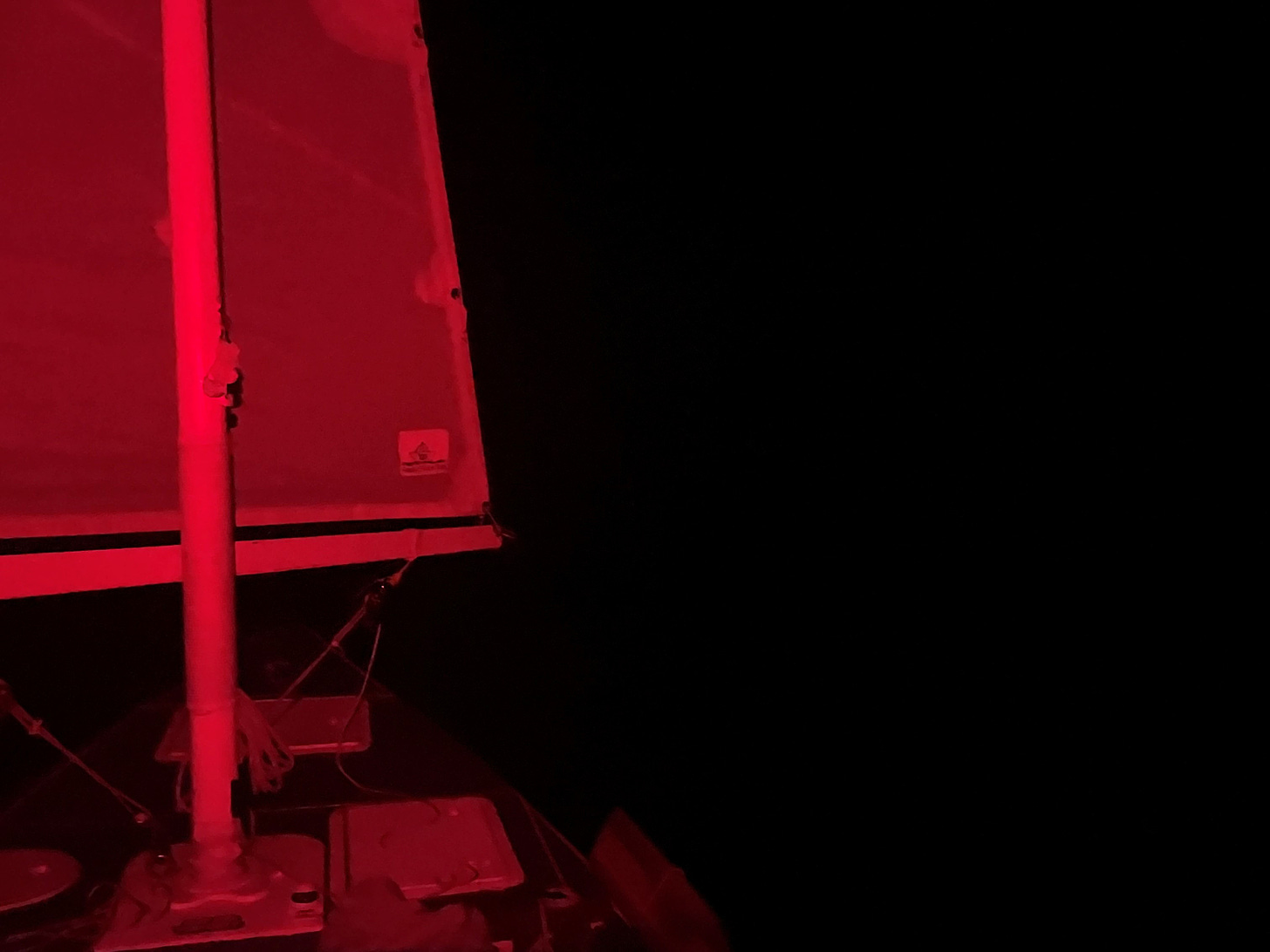
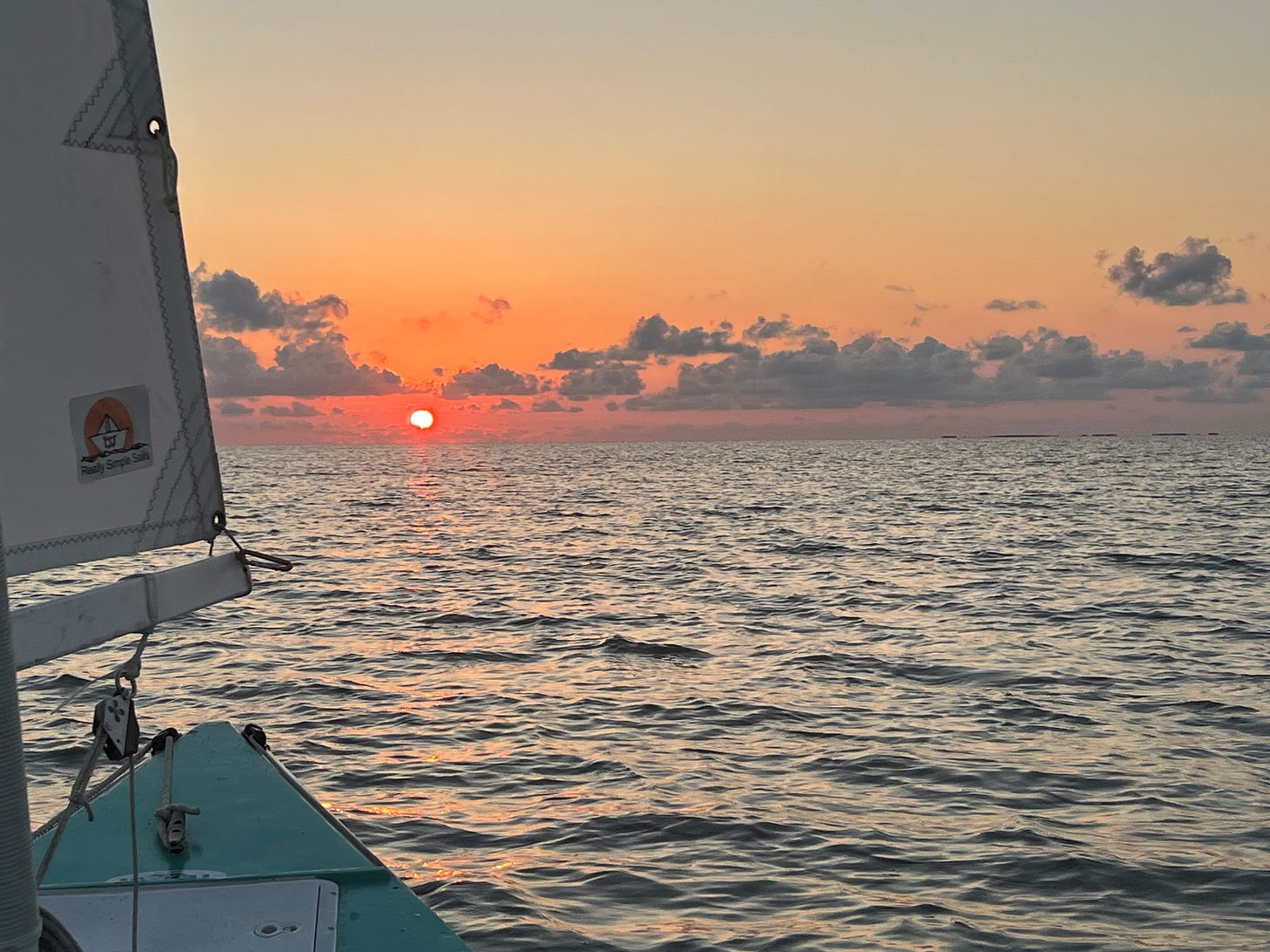
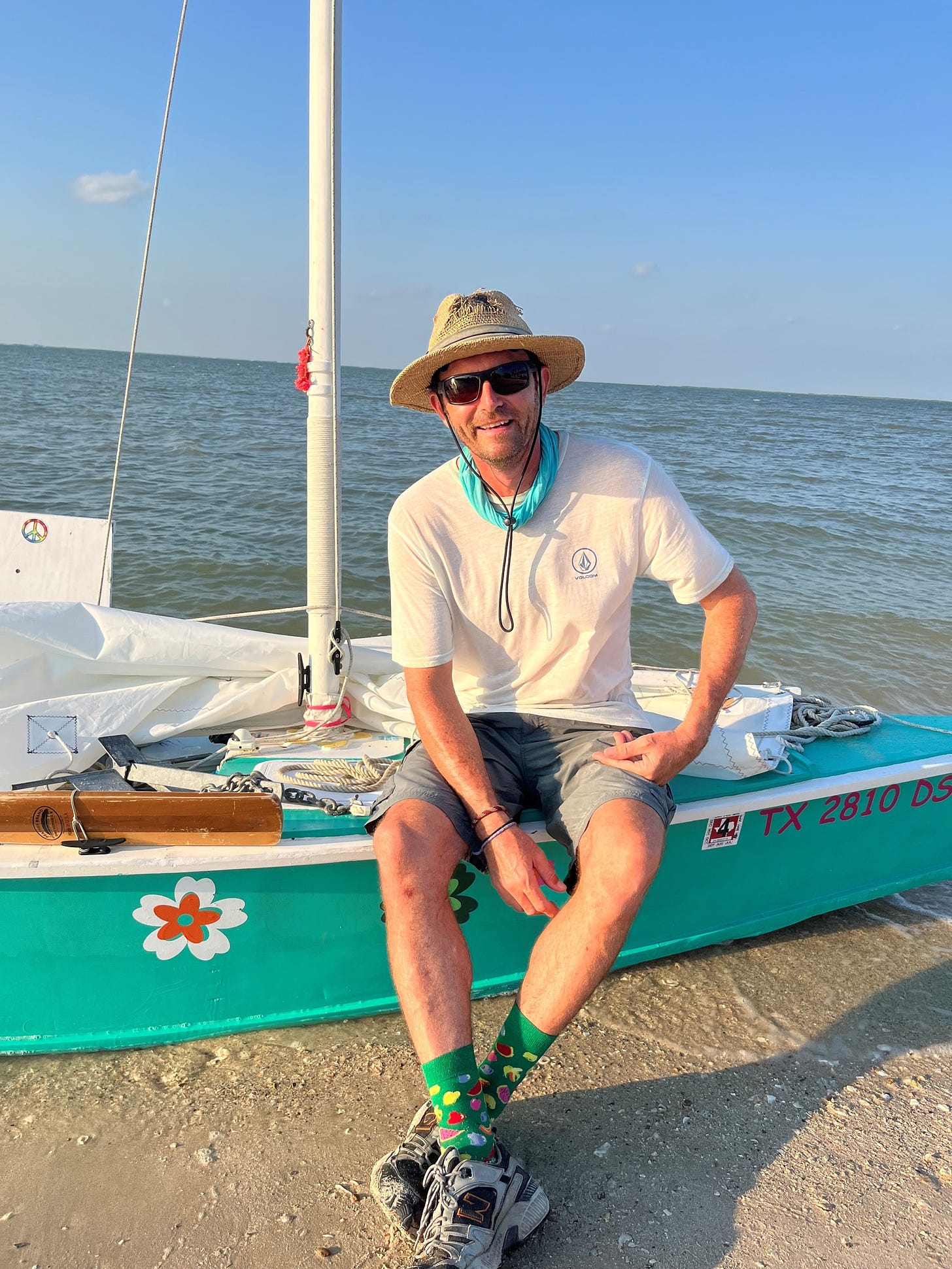
Thanks for the write-up. Your week makes my nine weeks on Tuffy seem like cruise ship luxury. Congrats for making it… again!
Cheers,
Ruffy
Thanks to your excellent writing and details coupled with having visited those camps in the 200 in the "good weather year" of '08 I felt your pain, your, achievements each day. Thank you so much for your well done story.